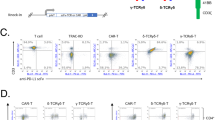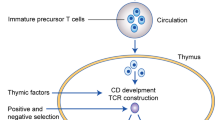Abstract
Genetically engineered expression of tumor-specific single chain antibody chimeric receptors (ch-Rec) on human T lymphocytes endow these cells with the parental monoclonal antibody (mAb) dictated tumor specificity and may be useful for clinical immuno-genetherapy. Therefore it was of importance to assess how the densities of tumor-specific receptors and tumor associated antigens (TAA), respectively, affect primary human T lymphocyte functions in relation to target cell susceptibilities to lysis. We therefore studied the functional balance between ch-Rec densities on human T lymphocytes and TAA on tumor cells. The gene construct encoding a ch-Rec derived from (1) a renal carcinoma cell (RCC) specific mouse mAb (G250), and (2) the human signal transducing Fc(ε)RI γ-chain was used. To obtain ch-RecHIGH-POS and ch-RecLOW-POS T lymphocytes, two distinct retroviral vectors were used to introduce the gene constructs into primary human T lymphocytes. Levels of ch-Rec-redirected T lymphocyte mediated tumor cell lysis, as well as lymphokine production were determined using RCC lines as target/stimulator cells, which express either no or increasing densities of the TAA. A functional and dynamic balance between ch-Rec densities on cytotoxic T lymphocytes (CTLs) on the one hand and TAA densities on RCCs on the other, was found. In short, ch-RecHIGH-POS CTLs are triggered by TAAHIGH-POS as well as TAALOW-POS RCCs to lyse tumor cells and produce (IFN-γ and TNF-α) lymphokine. In contrast, ch-RecLOW-POS T lymphocytes are only triggered for cytolysis and lymphokine production by relatively TAAHIGH-POS RCCs. In conclusion, (1) the activation of T lymphocyte responses is co-determined by the expression levels of the ch-Rec on T lymphocytes and the TAA on tumor cells and (2) at relatively high T lymphocyte ch-Rec expression levels the CTLs lyse tumor cells with a wide range of TAA densities.
This is a preview of subscription content, access via your institution
Access options
Subscribe to this journal
Receive 12 print issues and online access
$259.00 per year
only $21.58 per issue
Buy this article
- Purchase on Springer Link
- Instant access to full article PDF
Prices may be subject to local taxes which are calculated during checkout






Similar content being viewed by others
References
Bolhuis RLH et al. Cell–cell interactions Clin Immunol Allergy 1986 6: 29–90
Janeway CA Jr et al. Signals and signs for lymphocyte responses Cell 1994 76: 275–285
Perez P et al. Specific targeting of cytotoxic T cells by anti-CD3 linked to anti-target antibody Nature 1985 316: 354–356
Bolhuis RLH et al. Adoptive immunotherapy of ovarian carcinoma with bsmAb-targeted lymphocytes: a multicenter study Int J Cancer 1992 7: 78–81
Kanagawa O et al. Requirement of the T cell antigen receptor occupancy for the target cell lysis by cytolytic T lymphocytes Int Immunol 1989 1: 565–569
Braakman E et al. ICAM-melanoma cells are relatively resistant to CD3-mediated T cell lysis Int J Cancer 1990 46: 475–480
Goedegebuure PS et al. Lymphocyte leukocyte function-associated antigen 1 interacting with target cell intercellular adhesion molecule 1 co-activates cytolysis triggered via CD16 or the receptor involved in major histocompatibility antigen-unrestricted lysis Int Immunol 1990 2: 1213–1220
Blank-Voorthuis CJAC et al. Clustered CD3/TCR complexes do not transduce activation signals after bispecific monoclonal antibody-triggered lysis by cytotoxic T lymphocytes via CD3 J Immunol 1993 151: 2904–2914
Valitutti S et al. Degradation of T cell receptor (TCR)-CD3-zeta complexes after antigenic stimulation J Exp Med 1997 185: 1859–1864
Valitutti S et al. Different responses are elicited in cytotoxic T lymphocytes by different levels of T cell receptor occupancy J Exp Med 1996 183: 1917–1921
Blichfelt E et al. Dual T cell receptor T cells have a decreased sensitivity to physiological ligands due to reduced density of each T cell receptor Eur J Immunol 1996 26: 2876–2884
Hemmer B et al. Relationships among TCR ligand potency, thresholds for effector function elicitation, and the quality of early signaling events in human T cells J Immunol 1998 160: 5807–5814
Munthe LA et al. T cells with two TCR-beta chains and reactivity to both MHC/idiotypic peptide and superantigen Cell Immunol 1996 170: 283–290
Viola A et al. T cell activation determined by T cell receptor number and tunable thresholds Science 1996 273: 104–106
Rosenberg SA . Cancer vaccines based on the identification of genes encoding cancer regression antigens Immunol Today 1997 18: 175–182
Eshhar Z et al. Chimeric T cell receptor which incorporates the anti-tumour specificity of a monoclonal antibody with the cytolytic activity of T cells: a model system for immunotherapeutical approach Br J Cancer 1990 62: 27–29
Eshhar Z et al. The T-body approach: potential for cancer immunotherapy Semin Immunopathol 1996 18: 199–209
Bolhuis RLH . Genetic re-targeting of T lymphocyte specificity Gene Therapy 1998 5: 1153–1155
Hwu P et al. Lysis of ovarian cancer cells by human lymphocytes redirected with a chimeric gene composed of an antibody variable region and the Fc receptor gamma chain J Exp Med 1993 178: 361–366
Roberts MR et al. Targeting of human immunodeficiency virus-infected cells by CD8+ T lymphocytes armed with universal T cell receptors Blood 1994 84: 2878–2889
Weijtens MEM et al. Single chain Ig/gamma gene-redirected human T lymphocytes produce cytokines, specifically lyse tumor cells, and recycle their lytic capacity J Immunol 1996 157: 836–843
Weijtens MEM et al. Chimeric scFv/gamma receptor-mediated T cell lysis of tumor cells is co-regulated by adhesion and accessory molecules Int J Cancer 1998 77: 181–187
Weijtens MEM et al. A retroviral vector system STITCH in combination with an optimized single chain antibody chimeric receptor gene structure allows efficient gene transduction and expression in human T lymphocytes Gene Therapy 1998 5: 1195–1203
Eshhar Z et al. Specific activation and targeting of cytotoxic lymphocytes through chimeric single chains consisting of antibody-binding domains and the gamma or zeta subunits of the immunoglobulin and T-cell receptors Proc Natl Acad Sci USA 1993 90: 720–724
Hwu P et al. In vivo antitumor activity of T cells redirected with chimeric antibody/T-cell receptor genes Cancer Res 1995 55: 3369–3375
Hekele A et al. Growth retardation of tumors by adoptive transfer of cytotoxic T lymphocytes reprogrammed by CD44v6-specific scFv:zeta-chimera Int J Cancer 1996 68: 232–238
Altenschmidt U et al. Adoptive transfer of in vitro targeted, activated T lymphocytes results in total tumor regression J Immunol 1997 159: 5509–5515
Oosterwijk E et al. The use of monoclonal antibody G250 in the therapy of renal cell carcinoma Semin Oncol 1995 22: 34–41
van Dijk J et al. Induction of tumor cell lysis by bi-specific monoclonal antibodies recognizing renal cell carcinoma and CD3 antigen Int J Cancer 1989 43: 344–349
Valitutti S et al. Serial triggering of many T-cell receptors by a few peptide-MHC complexes Nature 1995 375: 148–151
Rotnes JS et al. Ca2+ mobilization in physiologically stimulated single T cells gradually increases with peptide concentration (analog signaling) Eur J Immunol 1994 24: 851–858
Alvarez-Vallina L et al. Efficient discrimination between different densities of target antigen by tetracycline-regulatable T bodies Hum Gene Ther 1999 10: 559–563
Fleuren GJ et al. Tumor heterogeneity and immunotherapy of cancer Immunol Rev 1995 145: 97–122
Uemura H et al. Internal image anti-idiotype antibodies related to renal-cell carcinoma-associated antigen G250 Int J Cancer 1994 56: 609–614
Miller AD et al. Improved retroviral vectors for gene transfer and expression Biotechniques 1989 7: 980–990
Braakman E et al. Expression of CD45-isoforms by fresh and activated human gamma delta T lymphocytes and natural killer cells Int Immunol 1991 3: 691–697
van de Griend RJ et al. Rapid expansion of allospecific cytotoxic T cell clones using nonspecific feeder cell lines without further addition of exogenous IL-2 Transplantation 1984 38: 401–406
van de Griend RJ et al. Rapid expansion of human cytotoxic T cell clones: growth promotion by a heat-labile serum component and by various types of feeder cells J Immunol Meth 1984 66: 285–298
Acknowledgements
This work was supported by the Dutch Technology Foundation ‘Stichting Technische Wetenschappen’ (project RGN44.3498), and the Dutch Cancer Society ‘Koningin Wilhelmina Fonds’ (project DDHK92–115).
Author information
Authors and Affiliations
Rights and permissions
About this article
Cite this article
Weijtens, M., Hart, E. & Bolhuis, R. Functional balance between T cell chimeric receptor density and tumor associated antigen density: CTL mediated cytolysis and lymphokine production. Gene Ther 7, 35–42 (2000). https://doi.org/10.1038/sj.gt.3301051
Received:
Accepted:
Published:
Issue Date:
DOI: https://doi.org/10.1038/sj.gt.3301051
Keywords
This article is cited by
-
Anti-GD2/4-1BB chimeric antigen receptor T cell therapy for the treatment of Chinese melanoma patients
Journal of Hematology & Oncology (2018)
-
Development of T cells carrying two complementary chimeric antigen receptors against glypican-3 and asialoglycoprotein receptor 1 for the treatment of hepatocellular carcinoma
Cancer Immunology, Immunotherapy (2017)
-
Anti-melanoma activity of T cells redirected with a TCR-like chimeric antigen receptor
Scientific Reports (2014)
-
TanCAR: A Novel Bispecific Chimeric Antigen Receptor for Cancer Immunotherapy
Molecular Therapy - Nucleic Acids (2013)
-
Retargeting NK‐92 for anti‐melanoma activity by a TCR‐like single‐domain antibody
Immunology & Cell Biology (2013)



